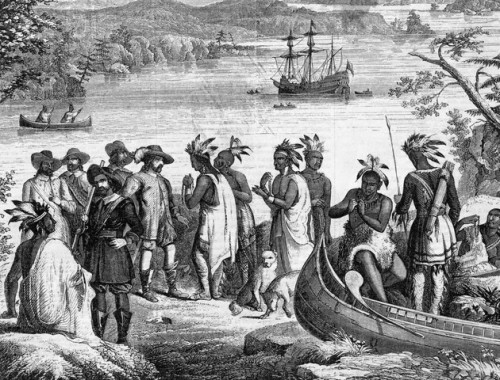Arrival of the Europeans

In 1609, English explorer Henry Hudson, sailing for the Netherlands, went up the river that now bears his name. His visit laid the foundation for the extensive Dutch settlement that followed.
Early in the seventeenth century, the Dutch West India Company established a trading post on high ground in present-day Jersey City, calling it Bergen (Dutch for hill). Dutch settlers soon realized that the Hackensack River was a rich environment for farming and extraction.
The Dutch settlement that began in the mid 17th century was part of New Netherland. The region was called Achter Kol, meaning “rear pass” or “behind the ridge”, to describe the valleys west of the Palisades, which afforded passage to trapping grounds in the northern hinterlands.
These Dutch farmers began to drain the swamps and remove native Atlantic White Cedar trees. Over the years, close to 14,000 acres disappeared under agricultural and mosquito ditches– and, later, factories, and landfills.
The Europeans treated the land and the water much the same as they treated the indigenous people who lived there. The Dutch traders and farmers had no respect for the native population and treated them with contempt, even looking upon them as possible slaves. Their attitude, however, did not prevent them from trading rum and guns for pelts and furs.
On February 25, 1643, an incident in what is now Jersey City paved the way for the destruction of indigenous culture in the region. William Kieft, Director of New Netherlands– appointed by the Dutch West India Company– ordered “an assault on a large group of Indians encamped at Pavonia, to wipe their chops and drive away and destroy the savages.”
He added that the soldiers should “spare as much as it is possible their wives and children.” But the soldiers “forgot” to spare the women & children– and the massacre was horrible. In retaliation for the Pavonia Massacre, eleven tribes of the Iroquois nation banded together, from the Raritan River to the Connecticut River. A truce was finally secured in 1645.
When England took over from the Dutch in 1664, there was considerably less violence. But havoc caused by the English took a different twist: they simply wanted the land. It must have been impossible for the Lenape to understand that they were signing away land for trinkets. All over New Jersey there are tales of the bargains that were made for the purchase of the lands from the “Indians”.
The destruction of native culture went hand-in-hand with dramatic changes to the land itself, most obviously in the Meadowlands. The landscape was quickly altered as the Europeans began to drain the marshes, create mosquito ditches, cut down native trees and bring in invasive plants like the phragmites. The phragmites are invasive reeds that replaced the native spartina grass and, to this day, became the dominant plant of the region.
